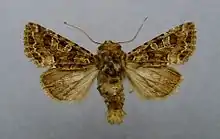Hadena perplexa
Hadena perplexa, the tawny shears or pod lover, is a species of moth of the family Noctuidae. It is found in Morocco, Algeria, Tunisia, Europe, Turkey, Israel, Lebanon, Syria, Jordan, Iran, Iraq, northern Asia, Central Asia, northern India and western China.

| Hadena perplexa | |
|---|---|
 | |
| Scientific classification | |
| Domain: | Eukaryota |
| Kingdom: | Animalia |
| Phylum: | Arthropoda |
| Class: | Insecta |
| Order: | Lepidoptera |
| Superfamily: | Noctuoidea |
| Family: | Noctuidae |
| Genus: | Hadena |
| Species: | H. perplexa |
| Binomial name | |
| Hadena perplexa (Denis & Schiffermüller, 1775) | |
| Synonyms | |
| |
Technical description and variation
The wingspan is 27–36 mm. Forewing olive grey brown or olive ochreous, clouded with darker; claviform stigma large, dark; orbicular and reniform with brown centres and white rings outlined with black; some black toothlike marks before submarginal line; hindwing dirty grey, darker towards termen; the veins dark. This darker form is the usual one throughout Europe; but is replaced in Britain by ochracea Haw. which is pale ochraceous with slightly darker markings; examples with an actually white ground colour are found on the chalk of the South of England, ab. pallida Tutt on the other hand, the darkest forms of ochracea Haw., with few markings but uniform in coloration, are known as brunnea Tutt.[1]
Biology
Adults are on wing from February to May in one generation in Israel. In Europe flying from April to June, depending on the microclimate of the habitat locally bivoltine, flying from April to June and from August to September.
Larva pale putty colour, with the lines indistinct. The larvae feed on the flowers and seeds of Dianthus, Lychnis and Silene species. Other recorded food plants include Melandrium viscosum, Melandrium rubrum and Viscaria vulgaris.[2]
Subspecies
- Hadena perplexa perplexa
- Hadena perplexa paghmana (Afghanistan)
- Hadena perplexa plantei
- Hadena perplexa capsophila
References
- Seitz, A. Ed., 1914 Die Großschmetterlinge der Erde, Verlag Alfred Kernen, Stuttgart Band 3: Abt. 1, Die Großschmetterlinge des palaearktischen Faunengebietes, Die palaearktischen eulenartigen Nachtfalter, 1914
- "Robinson, G. S., P. R. Ackery, I. J. Kitching, G. W. Beccaloni & L. M. Hernández, 2010. HOSTS - A Database of the World's Lepidopteran Hostplants. Natural History Museum, London".